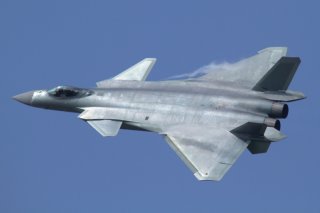China’s 5th-Generation J-20 Stealth Fighters Patrol East and South China Seas
China is seeking to counter the U.S. F-35 and F-22 fighter jets while challenging U.S. air dominance in the Pacific.
China’s People’s Liberation Army (PLA) Air Force has recently conducted several patrol flights of its J-20 fifth-generation stealth fighter with the intent to counterbalance the growing presence of U.S. F-35 stealth fighters in the region.
“It is certain that the J-20, as advanced new equipment, will appear on potential battlefields, including at sea, particularly when advanced warplanes of the US like the F-35 and the F-22 have been flying near China,” Song Zhongping, a Chinese defense expert, told the Chinese government-backed Global Times newspaper.
China’s push to extol the J-20 could, at least to some extent, be aimed at masking several glaring Chinese deficiencies when it comes to air power in the Pacific. China does not have a fighter jet that can duplicate the F-35-B’s short takeoff and vertical landings and is only now starting to produce its first fifth-generation, stealthy, carrier-launched fighter. Thus, when it comes to the ability to project fifth-generation air power from the sea, China is far behind the United States in terms of both technological innovation and sheer numbers.
It’s not clear how soon China’s carrier-launched J-31 might be operational, and there will be a need to produce large numbers of them to rival the U.S. F-35B and F-35C. Of course, it is not just the United States that is driving this imbalance, but U.S. Pacific allies like Japan, which is also acquiring a large number of its own F-35s as well. Chinese officials say they are revving up production of the J-20 and highlight its recently upgraded, domestically built WS-10C engine. It is not clear exactly how many J-20s the PLA has already produced, but multiple accounts suggest the number is much smaller than the hundreds of F-35s operated by the United States.
But it’s also about more than numbers: China’s land-launched J-20 may also suffer a range problem, certainly when it comes to the South China Sea. One reason China is drawing attention to its J-20 may be because it would be able to reach Taiwan on a single sortie, given that the island is only 100 miles away from mainland China. This proximity could allow the J-20 to fly attack missions over or near Taiwan and still be able to return without having to refuel. Essentially, the J-20 could present a clear threat to Taiwan and create a circumstance wherein the United States would need to forward position carriers and amphibious assault ships to ensure its F-35s are ready to counter a Chinese air assault.
The South China Sea is a different story, as the Spratly islands are roughly 500 miles off the coast of mainland China, a distance which might make it extremely difficult to reach and conduct operations near without substantial aerial refueling assets. A single J-20 sortie is unlikely to be able to reach the South China Sea and perform missions without having a ship to land on or an accompanying aerial tanker to refuel it. But the J-20 is not built to land on ships, and flying large tankers presents great risks and increases the likelihood of attack.
Kris Osborn is the Defense Editor for the National Interest. Osborn previously served at the Pentagon as a Highly Qualified Expert with the Office of the Assistant Secretary of the Army—Acquisition, Logistics & Technology. Osborn has also worked as an anchor and on-air military specialist at national TV networks. He has appeared as a guest military expert on Fox News, MSNBC, The Military Channel, and The History Channel. He also has a Master’s Degree in Comparative Literature from Columbia University.
Image: Wikipediahttps://en.wikipedia.org/wiki/Chengdu_J-20#/media/File:J-20_at_Airshow_China_2016.jpg.

